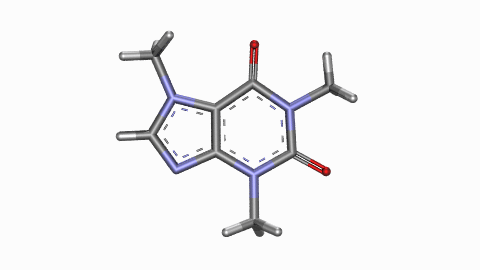Cheap, Safe and Legal: Caffeine, The Socially Acceptable Psychoactive Drug
What does it look like?

The crystal structure of caffeine. The carbon atoms are grey, the oxygen atoms are red, the nitrogen atoms are blue and the hydrogen atoms are white. Images generated using POV-Ray (The Persistence of Vision Ray-Tracer; http://www.povray.org) and complied with VideoMach (www.gromada.com/videomach/).
What is it?
This is the crystal structure of one of the two anhydrous forms of caffeine. Caffeine is a stimulant naturally present in a number of plants, particularly in seeds of coffee plants and the leaves of tea bushes. Some plants use caffeine as a pesticide, deterring insects from eating them, while other plants use it as a reward for insects and animals that pollinate them.
In humans, caffeine acts as a psychoactive drug affecting the central nervous system and metabolic receptors, particularly the adenosine A2A receptors. The results of caffeine ingestion vary depending on the dose and can include: restoring alertness, overcoming fatigue, increasing endurance, improving glucose metabolism and overcoming drowsiness. Caffeine is addictive and can have side effects including: heart palpitations, irritability, insomnia and headaches.
Caffeine is most commonly consumed in the form of coffee, which itself has been shown to have a number of potential benefits including allowing crystallographers to stay awake all night and collect data and reducing the risks of: type-2 diabetes; liver cirrhosis; cardiovascular disease; asthma; and a variety of cancers. It is possible to overdose on caffeine, although with an LD50 of ~200 mg/kg consumption of at least 100 cups of coffee for an average person would be required to reach a potentially lethal dose. Over 120,000 tonnes of caffeine is consumed annually.
Where did it come from?
Despite its ready availability, low cost and interesting pharmaceutical properties, the single-crystal structure of the anhydrous form was not obtained until 2007 (although the hydrated analogue was determined in 1958!).
To obtain the anhydrous structure, single crystals had to be grown by either sublimation at 430 K or by keeping a sample of the material submerged under carbon disulfide for several months. The difficulties in growing these crystals were attributed to a lack of any strong intermolecular interactions present in the crystal lattice. The crystal structures were reported in: "The Structure of Two Anhydrous Polymorphs of Caffeine from Single-Crystal Diffraction and Ultrahigh-Field Solid-State 13C NMR Spectroscopy", G. D. Enright, V. V. Terskikh, D. H. Brouwer, J. A. Ripmeester, Cryst. Growth & Design, 2007, 7, 1406-1410 and the CIFs are available here.




